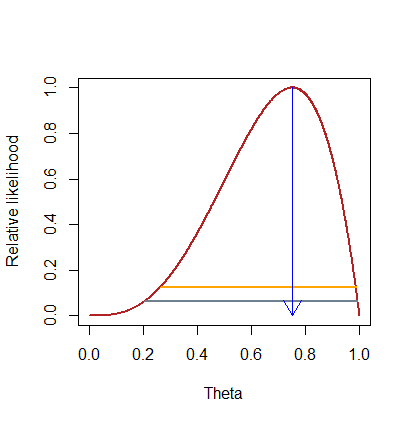When using the likelihood method, plotting the relative likelihood or evidence against the range of possible values for the parameter ($\theta$) being estimated results in a curve. The maximum value will indicate the estimated parameter with the maximum likelihood (most supported by the data), $MLE=argmax_\theta \mathcal{L}(\theta|x)$, and a range can be extracted such that all the $\theta$ values are supported more than $1/8$ (horizontal orange line below) or $1/16$ (horizontal gray line) as compared to the maximum are highlighted (an estimated range).
For example, in the experiment of throwing a die multiple times, and observing the number of heads to estimate the probability of getting heads (bias),
n <- 4 # Number of coin flips
x <- 3 # Number of heads
theta <- seq(from=0, to=1, by = 0.001) # Possible range of probabilities of getting H.
L <- theta^x*(1-theta)^(n-x) # Likelihood of each theta given x.
df<- as.data.frame(cbind(theta,L))
maxL <- max(L)
ML_theta<-df$theta[which(df$L==maxL)]
plot(L/maxL ~ theta, type='l', col='firebrick', lwd=2, xlab="Theta",
ylab="Relative likelihood")
lines(range(theta[L/maxL>1/8]), c(1/8,1/8), col='orange', lwd=2)
lines(range(theta[L/maxL>1/16]), c(1/16,1/16), col='slategray', lwd=2)
arrows(x1=ML_theta,x0=ML_theta, y1=0, y0=1, col='blue')
the MLE is $\theta = p(H)=0.75$ if we know that we got $3 \, heads\,1\, tail$, but the possible true probability of getting heads can be different, except for $0$ or $1$, and we may give a range of $\theta$'s with a minimum support of $1/8$, range(theta[L/maxL>1/8])= 0.262 to 0.986, (or similarly, we could do the same for $1/16$, yielding 0.203 to 0.993) relative to the maximum. This makes sense.
The question refers to the wording in the Coursera course (lecture 6 (slide 15)) I came across this, and the wording that is repeated several times in the recorded lecture:
"Parameter values above the $1/8$ reference line, for example, are such that no other point is more than 8 times better supported given the data."
Is the wording obtruse by necessity or by choice? Is my interpretation above wrong or incomplete, explaining why I'm missing the need for this painful and cryptic wording of the meaning of the plot?

